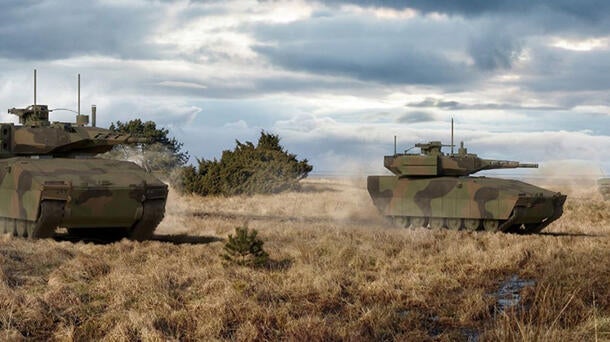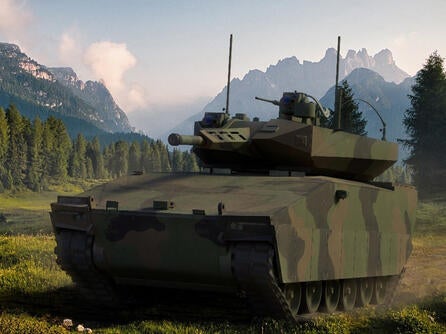The U.S. Army has a long and impressive history of making and inspiring new inventions. It includes some foundational technology in use today – all modern computers come from systems built by the Army Research Laboratory. But it also covers more practical territory, like duct tape, insect spray and aviator sunglasses.
Whatever the technology, all had one goal in mind, and that is to ensure the U.S. Army was better equipped than its adversaries.
Today that same spirit lives on in efforts to create new weapons and other systems to keep the Army ahead of new and rapidly evolving threats. To feed this innovation and stay at the technological forefront, L3Harris is working with our Army customers to use Modular Open Systems Approaches (MOSA) to preserve advantages for soldiers in the field.
MOSA ties into the Army’s Futures Command (AFC) which formed in 2018 to focus on modernization efforts. Its eight cross functional teams tie into Army priorities, including Next Generation Combat Vehicles (NGCV), Army networks and Future Vertical Lift (FVL).
These teams are part of the Army’s continuous technology modernization and transformation effort -- essential as adversaries continue to become more agile. MOSA is at the forefront of the AFC’s modernization effort, which the Army has indicated is paramount in achieving overmatch, commonality and total lifecycle affordability.
The magnitude of MOSA’s impact on Army modernization is far-reaching. It is more than following a defined set of standards, it’s an approach that enables latest technology integration at the speed of relevancy, whether it be weapons, navigation or communication. It ensures sustained interoperability and protected operations on the future battlefield – wherever that may be.
WHY IS IT SO IMPORTANT TO THE ARMY?
As MOSA quickly becomes an accepted approach within the Army and its industry partners, it becomes important to take a deeper dive into its strategy.
The Army adopted a MOSA technical and business approach to ensure its industry partners design affordable and adaptable systems that work in unison – with a consistent set of open interfaces and modular hardware and software elements. With industry partners implementing MOSA, the Army can now integrate new hardware or software solutions without having to make significant changes to the overall platform, as long as the solution conforms to the Army’s selected open interface standards.
This approach considerably reduces cost and downtime and rapidly provides the warfighter with the latest innovative, cutting-edge technology. This capability is critical when facing today’s ever-increasingly agile and adaptable near-peer threats.
HOW DO WE GET THERE?
For the Army to succeed at integrating open-systems approaches, consistent interfaces across multiple platforms, services and allies need to be a focus. This creates much larger markets, encourages industry adoption and investment, and allows for greater reuse and simplified digital interoperability.
Commitment in the form of strong “shall” statements in contracts will ensure ambiguous “do MOSA to the maximum extent practicable” jargon is eliminated, bringing the true industry experts into focus. Standards that come with objective measures of compliance and conformance are necessary to ensure the Army is truly getting an open system.
As a long-standing MOSA industry partner, L3Harris continues to contribute both expertise and technologically advanced solutions for many of the Army’s modernization priorities. One such effort is the Optionally Manned Fighting Vehicle (OMFV) which will replace the currently fielded M2 Bradley infantry fighting vehicle, part of the Next-Generation Combat Vehicle (NGCV) portfolio of programs.
As an integration partner to American Rheinmetall Vehicles (ARV), the prime on the program, L3Harris is providing leading-edge sights, communications and other mission capabilities to ARV’s Lynx offering, as well as providing MOSA subject-matter expertise.
“Lynx provides warfighters with leading-edge technology to dominate future battlefields,” said Matt Warnick, Managing Director for American Rheinmetall Vehicles. “A big part of retaining overmatch is modular open systems approaches and digital engineering, which L3Harris is a partner in providing, a strength of the American Rheinmetall Vehicles team and a benefit to the soldiers.”
OPENLY WORKING TOGETHER
L3Harris understands that to remain dominant, the Army must evolve faster and be more adaptable than its adversaries. As an industry partner to the Army, L3Harris continues to advance MOSA strategies and deliver verifiable open-systems solutions in the systems they provide.
As L3Harris continues to expand MOSA adoption into its latest technology offerings, the company remains committed to ensuring warfighters are mission ready by shortening technology development timelines, reducing maintenance and upgrade costs while creating interoperability and avoiding vendor lock so the Army can dominate the future battlefield.
As an example of its commitment to ensuring the latest technology and advancements are provided to the warfighter, L3Harris has recently introduced the Agile Development Group (ADG), an innovative team of engineers, program managers, technicians and operations professionals focused on accelerating capability development to address emerging threats and solve customers’ most vexing problems.
“We understand that to remain dominant, the U.S. must evolve faster and be more adaptable than its adversaries,” L3Harris Space and Airborne Systems President Ed Zoiss said. “This is only possible with MOSA, and we are committed to the Army’s mission to stay head of rapidly evolving threats by delivering technology, faster and more efficiently than ever before”.





